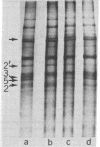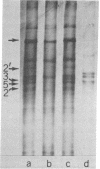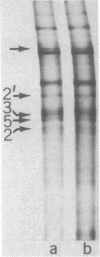Abstract
Testis proteins of Drosophila melanogaster deficient for six different Y-chromosome regions were fractionated by means of a sodium dodecyl sulfate/polyacrylamide gel system designed to separate high molecular weight polypeptides (Mr, greater than 200,000). Analysis of the banding patterns indicates that the three regions containing fertility genes kl-2, kl-3, and kl-5 are responsible for three different high molecular weight polypeptides. Several observations indicate that these polypeptides are structural components of the sperm axoneme. They are present in seminal vesicles, which are highly enriched for mature sperm. They are first detected during development at a time when the first spermatids are elongating. Finally, deletion of either kl-5 or kl-3 leads to the absence of the outer dynein arm of the peripheral doublets of the axoneme. Although absence of the kl-2 region eliminates the third polypeptide, an associated structural defect in the axoneme has yet to be identified. The three polypeptides are in the Mr 300,000-350,000 range, and their mobilities are similar to those of dynein polypeptides from Chlamydomonas axonemes. Experiments using dosage variation and a temperature-sensitive sterile mutation in kl-5 suggest that the Y-chromosome regions contain the coding sequences for the polypeptides.
Full text
PDF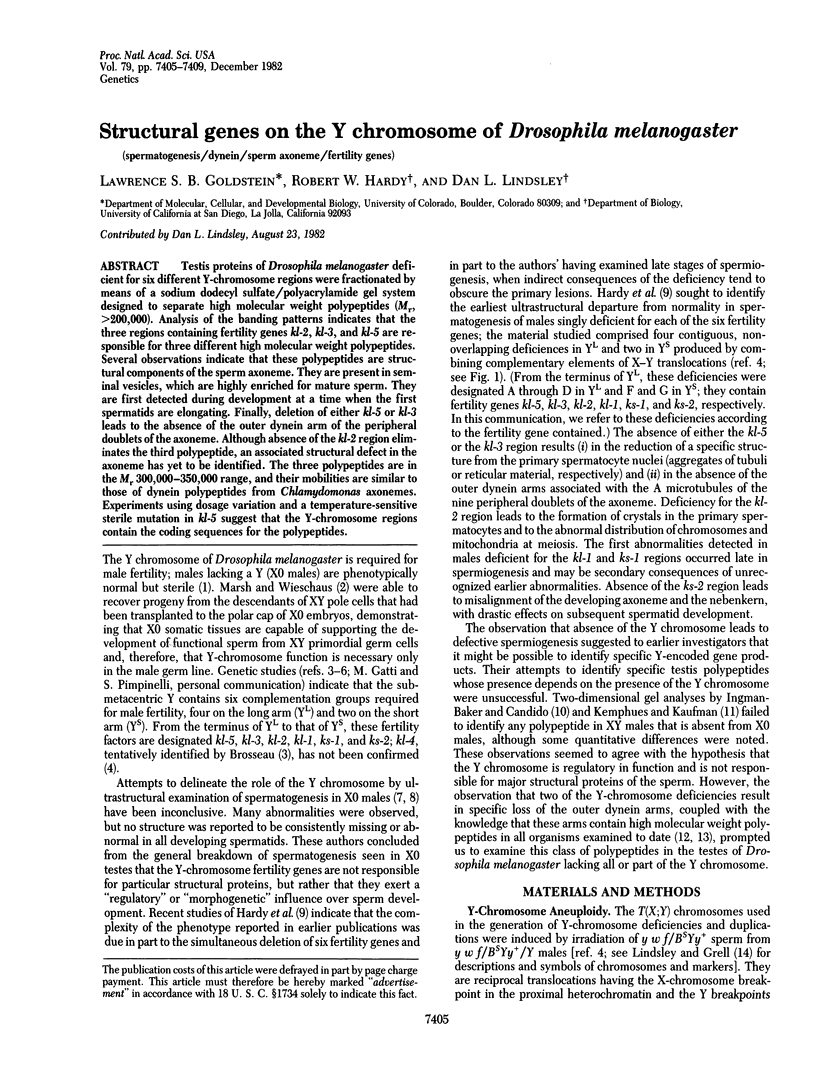
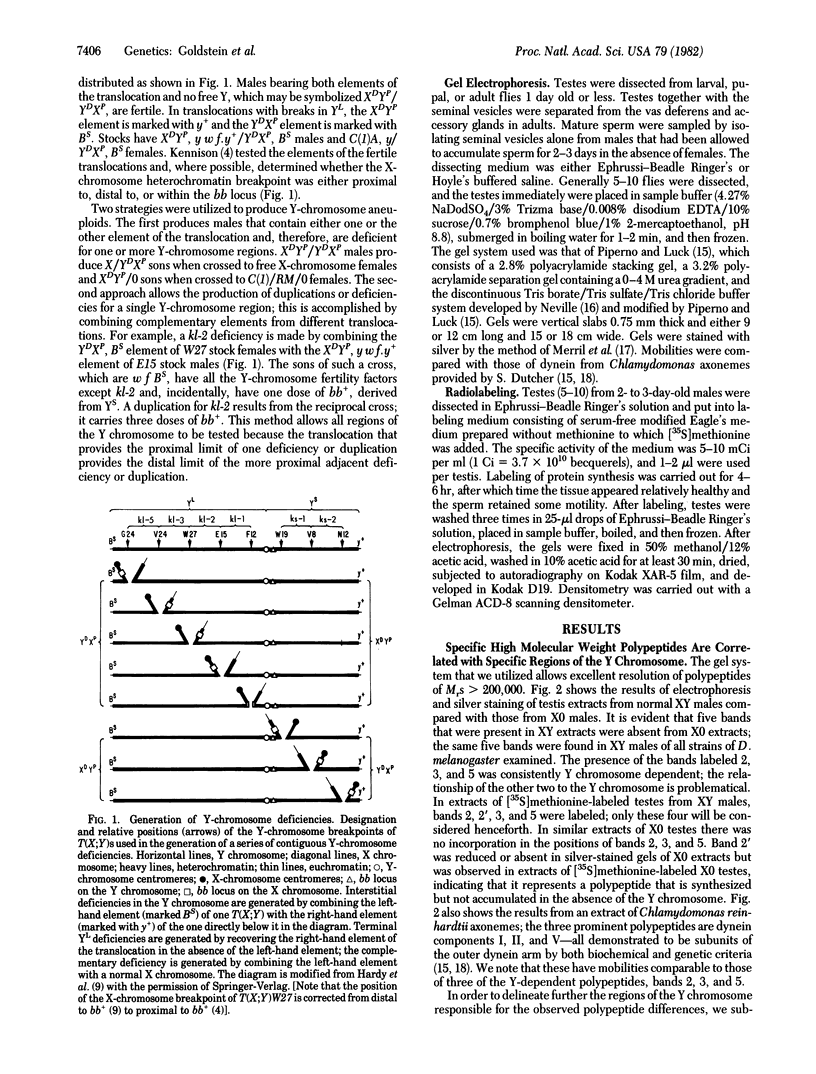
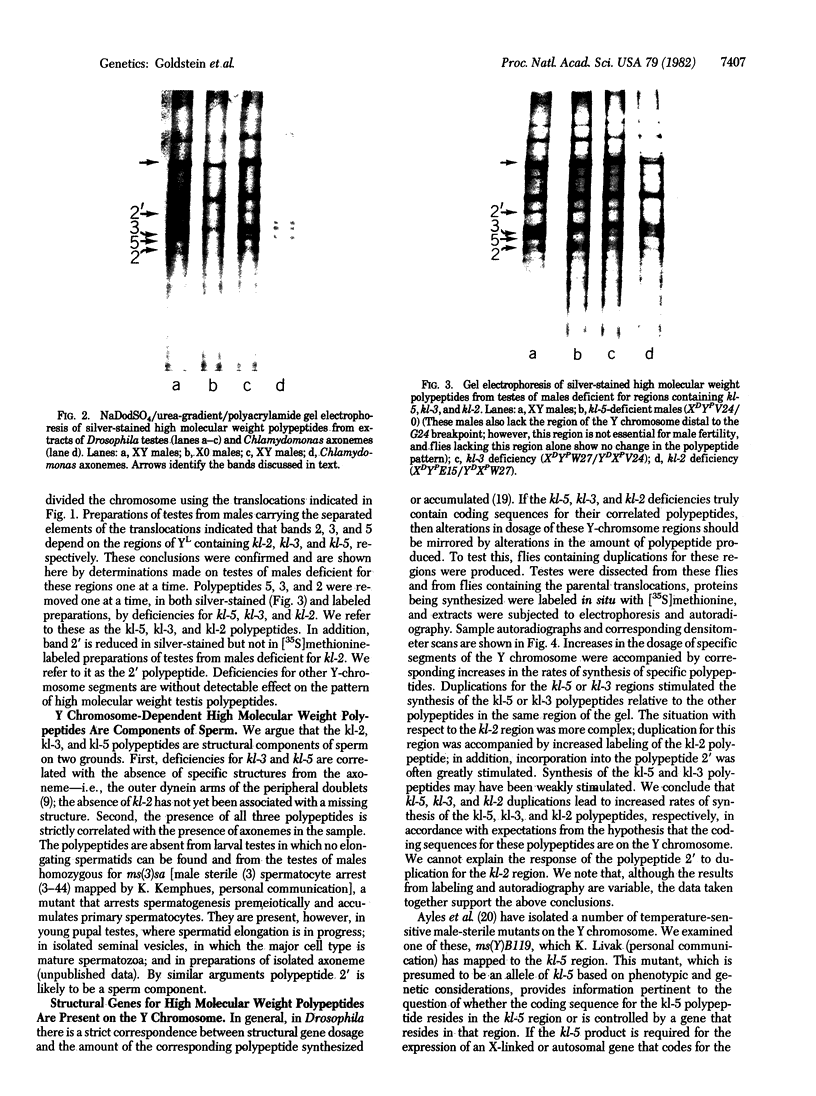
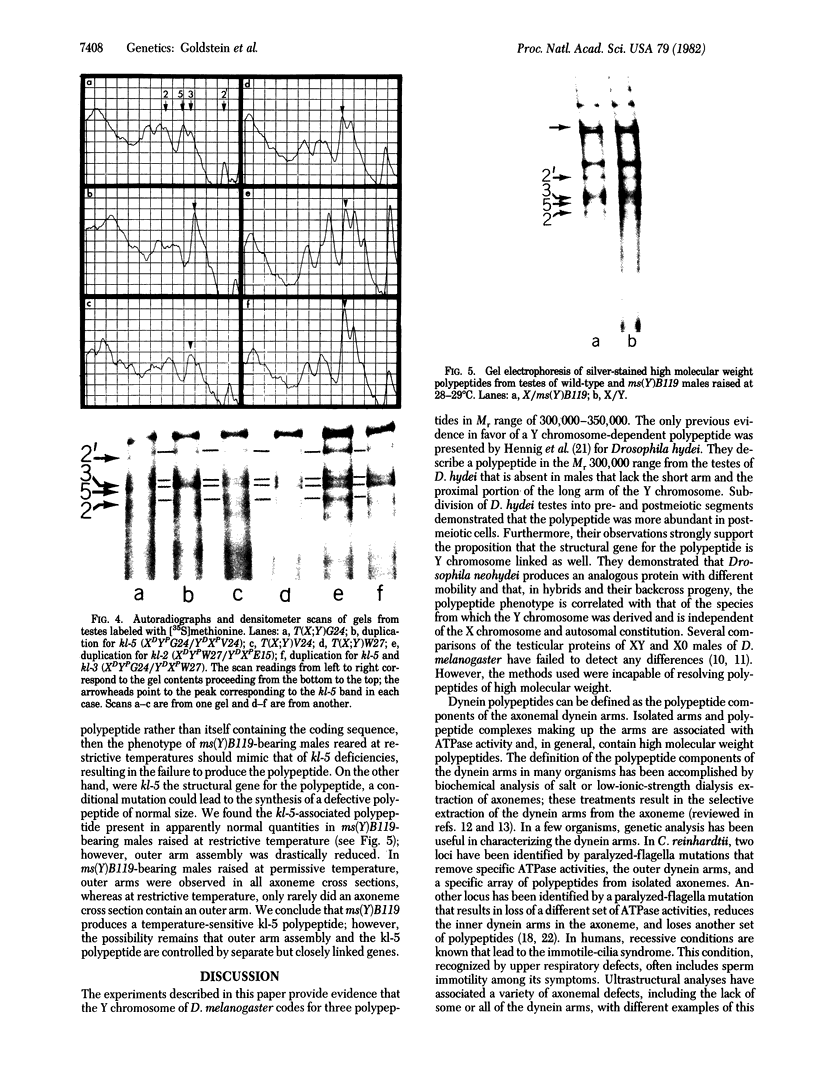
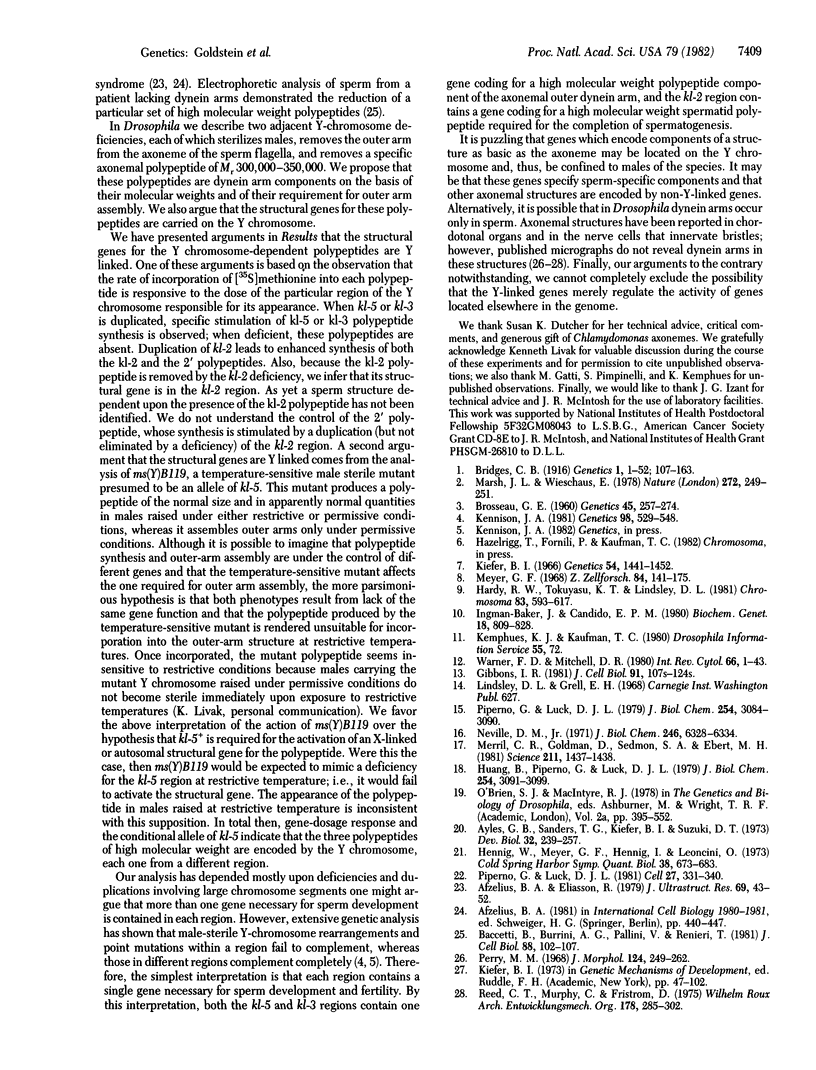
Images in this article
Selected References
These references are in PubMed. This may not be the complete list of references from this article.
- Afzelius B. A., Eliasson R. Flagellar mutants in man: on the heterogeneity of the immotile-cilia syndrome. J Ultrastruct Res. 1979 Oct;69(1):43–52. doi: 10.1016/s0022-5320(79)80041-6. [DOI] [PubMed] [Google Scholar]
- Ayles G. B., Sanders T. G., Kiefer B. I., Suzuki D. T. Temperature-sensitive mutations in Drosophila melanogaster. XI. Male sterile mutants of the Y chromosome. Dev Biol. 1973 Jun;32(2):239–257. doi: 10.1016/0012-1606(73)90239-x. [DOI] [PubMed] [Google Scholar]
- Baccetti B., Burrini A. G., Pallini V., Renieri T. Human dynein and sperm pathology. J Cell Biol. 1981 Jan;88(1):102–107. doi: 10.1083/jcb.88.1.102. [DOI] [PMC free article] [PubMed] [Google Scholar]
- Bridges C B. Non-Disjunction as Proof of the Chromosome Theory of Heredity. Genetics. 1916 Jan;1(1):1–52. doi: 10.1093/genetics/1.1.1. [DOI] [PMC free article] [PubMed] [Google Scholar]
- Brosseau G E. Genetic Analysis of the Male Fertility Factors on the Y Chromosome of Drosophila Melanogaster. Genetics. 1960 Mar;45(3):257–274. doi: 10.1093/genetics/45.3.257. [DOI] [PMC free article] [PubMed] [Google Scholar]
- Gibbons I. R. Cilia and flagella of eukaryotes. J Cell Biol. 1981 Dec;91(3 Pt 2):107s–124s. doi: 10.1083/jcb.91.3.107s. [DOI] [PMC free article] [PubMed] [Google Scholar]
- Hardy R. W., Tokuyasu K. T., Lindsley D. L. Analysis of spermatogenesis in Drosophila melanogaster bearing deletions for Y-chromosome fertility genes. Chromosoma. 1981;83(5):593–617. doi: 10.1007/BF00328522. [DOI] [PubMed] [Google Scholar]
- Hennig W., Meyer G. F., Hennig I., Leoncini O. Structure and function of the Y chromosome of Drosophila hydei. Cold Spring Harb Symp Quant Biol. 1974;38:673–683. doi: 10.1101/sqb.1974.038.01.072. [DOI] [PubMed] [Google Scholar]
- Huang B., Piperno G., Luck D. J. Paralyzed flagella mutants of Chlamydomonas reinhardtii. Defective for axonemal doublet microtubule arms. J Biol Chem. 1979 Apr 25;254(8):3091–3099. [PubMed] [Google Scholar]
- Ingman-Baker J., Candido E. P. Proteins of the Drosophila melanogaster male reproductive system: two-dimensional gel patterns of proteins synthesized in the XO, XY, and XYY testis and paragonial gland and evidence that the Y chromosome does not code for structural sperm proteins. Biochem Genet. 1980 Aug;18(7-8):809–828. doi: 10.1007/BF00484595. [DOI] [PubMed] [Google Scholar]
- Kennison J. A. The Genetic and Cytological Organization of the Y Chromosome of DROSOPHILA MELANOGASTER. Genetics. 1981 Jul;98(3):529–548. doi: 10.1093/genetics/98.3.529. [DOI] [PMC free article] [PubMed] [Google Scholar]
- Kiefer B. I. Ultrastructural Abnormalities in Developing Sperm of X/0 DROSOPHILA MELANOGASTER. Genetics. 1966 Dec;54(6):1441–1452. doi: 10.1093/genetics/54.6.1441. [DOI] [PMC free article] [PubMed] [Google Scholar]
- Marsh J. L., Wieschaus E. Is sex determination in germ line and soma controlled by separate genetic mechanisms? Nature. 1978 Mar 16;272(5650):249–251. doi: 10.1038/272249a0. [DOI] [PubMed] [Google Scholar]
- Merril C. R., Goldman D., Sedman S. A., Ebert M. H. Ultrasensitive stain for proteins in polyacrylamide gels shows regional variation in cerebrospinal fluid proteins. Science. 1981 Mar 27;211(4489):1437–1438. doi: 10.1126/science.6162199. [DOI] [PubMed] [Google Scholar]
- Meyer G. F. Spermiogenese in normalen und Y-defizienten Männchen von Drosophila melanogaster und D. hydei. Z Zellforsch Mikrosk Anat. 1968;84(2):141–175. [PubMed] [Google Scholar]
- Neville D. M., Jr Molecular weight determination of protein-dodecyl sulfate complexes by gel electrophoresis in a discontinuous buffer system. J Biol Chem. 1971 Oct 25;246(20):6328–6334. [PubMed] [Google Scholar]
- Perry M. M. Further studies on the development of the of Drosophila melanogaster. II. The interommatidial bristles. J Morphol. 1968 Feb;124(2):249–262. doi: 10.1002/jmor.1051240209. [DOI] [PubMed] [Google Scholar]
- Piperno G., Luck D. J. Axonemal adenosine triphosphatases from flagella of Chlamydomonas reinhardtii. Purification of two dyneins. J Biol Chem. 1979 Apr 25;254(8):3084–3090. [PubMed] [Google Scholar]
- Piperno G., Luck D. J. Inner arm dyneins from flagella of Chlamydomonas reinhardtii. Cell. 1981 Dec;27(2 Pt 1):331–340. doi: 10.1016/0092-8674(81)90416-5. [DOI] [PubMed] [Google Scholar]
- Warner F. D., Mitchell D. R. Dynein: the mechanochemical coupling adenosine triphosphatase of microtubule-based sliding filament mechanisms. Int Rev Cytol. 1980;66:1–43. doi: 10.1016/s0074-7696(08)61970-1. [DOI] [PubMed] [Google Scholar]



